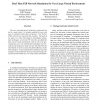Free Online Productivity Tools
i2Speak
i2Symbol
i2OCR
iTex2Img
iWeb2Print
iWeb2Shot
i2Type
iPdf2Split
iPdf2Merge
i2Bopomofo
i2Arabic
i2Style
i2Image
i2PDF
iLatex2Rtf
Sci2ools
110
Voted
DSRT
2006
IEEE
2006
IEEE
Real Time P2P Network Simulation for Very Large Virtual Environment
The ever increasing speed of Internet connections has led to a point where it is actually possible for every end user to seamlessly share data on Internet. Peer-To-Peer (P2P) networks are typical of this evolution. The goal of our paper is to show that thanks to self-adaptive assignment techniques, server-less P2P networks can efficiently deal with very large environments such as met in the geovisualisation area. Our method takes advantage of a hierarchical and progressive data structure that describes the environment. In order to assess the global efficiency of this P2P technique, we have implemented a dedicated real time simulator. Experimentation results are presented using a hierarchical LOD model of a very large urban environment.
DSRT 2006 | Hierarchical Lod Model | Modelling And Simulation | Self-adaptive Assignment Techniques | Server-less P2p Networks |
Related Content
| Added | 11 Jun 2010 |
| Updated | 11 Jun 2010 |
| Type | Conference |
| Year | 2006 |
| Where | DSRT |
| Authors | Romain Cavagna, Christian Bouville, Jérôme Royan |
Comments (0)

